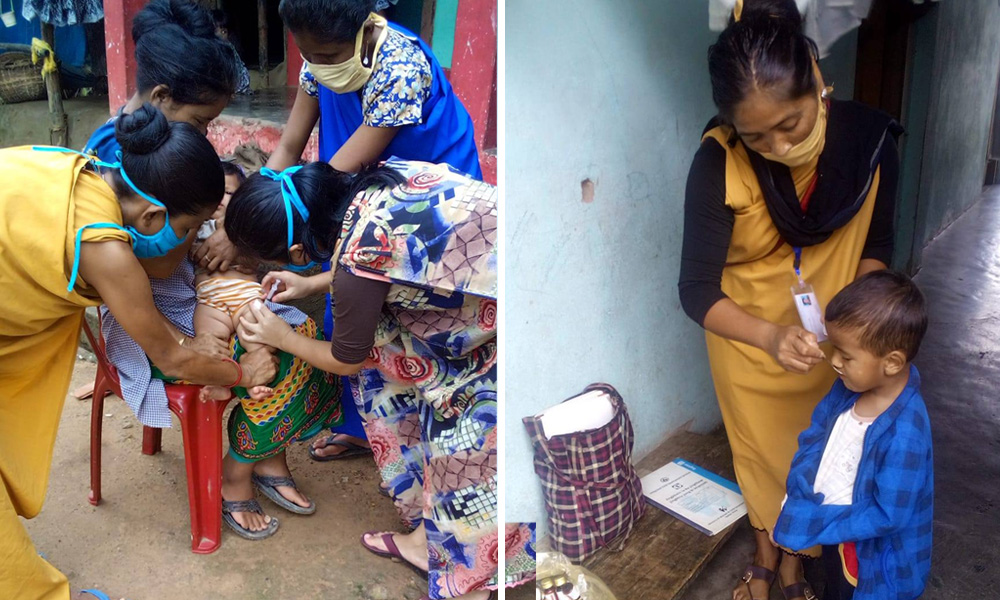
Meghalaya Turns Crisis Into Opportunity, Ranks Second In Nationwide Immunization Coverage
Writer: Shweta Raj Kanwar
Shweta Raj Kanwar is a Media & Communications officer working with the Government of Meghalaya. She is currently engaged in documentation of COVID-19 activities in the State.
Meghalaya, 8 Aug 2020 9:01 AM GMT | Updated 8 Aug 2020 10:49 AM GMT
Creatives : Abhishek M |
" An engineer by profession, Abhishek is the creative producer of the team, graphic designing is his passion and travelling his get away. In more ways than one, he makes the content visually appealing."
Guest Author : Shweta Raj Kanwar
Shweta Raj Kanwar is a Media & Communications officer working with the Government of Meghalaya. She is currently engaged in documentation of COVID-19 activities in the State.
Meghalaya has been able to achieve 90 per cent immunization coverage and now ranks second alongside Kerala, only after Telangana, in terms of immunization coverage in India.
Meghalaya, along with the rest of the world has been making all possible efforts to contain the spread of novel coronavirus and is one of the states in India with the lowest number of COVID-19 positive cases per million population. But, this is not the only thing that sets the state apart from others.
Meghalaya has been able to achieve 90 per cent immunization coverage and now ranks second alongside Kerala, only after Telangana, in terms of immunization coverage in India. From just 61.4% coverage between 2015-16 to achieving 90% coverage in July 2020, Meghalaya has been able to turn crisis into an opportunity.
The Full Immunization Coverage (FIC) in Meghalaya has increased from 61.4% (National Family Health Survey (NFHS)-4, 2015-16) to 90% (July 2020, Immunization Dashboard, Immunization Technical Support Unit (ITSU), Immunization Division, MOHFW, GOI). It should be noted that between the years 2015-19, the State had one of the lowest immunization coverage in the country, which in turn entailed an increase in Infant Mortality Rate (IMR) as well as the Maternal Mortality Rate (MMR), taking the State's MMR to be higher than the National Average.
The low rate of immunization also cost it a performance grant of Rs. 25 Crore in 2019 due to its inability to achieve full immunization target set by the Govt. of India (GOI). The situation demanded immediate intervention and hence, Meghalaya set out on a mission to make up for its inefficiency.
Challenges Meghalaya Faced In Achieving Full Immunization Coverage
Dr. Neelanjan Roy, State Surveillance Medical Officer, World Health Organization (WHO)- National Polio Surveillance Project (NPSP) explains that achieving full immunization coverage comes with its own set of challenges which can be classified into two broad types - 'Supply Side' and 'Demand Side' issues. Some of the supply side issues are:
Lack of critical manpower like Medical Officers, Health Supervisors, Auxiliary Nursing Midwifery (ANMs) and ASHAs in some areas.
Lack of suitable infrastructure for conducting routine immunization sessions in some outreach areas (Sub-centres/ AWW Centres) or in some remote villages where there is lack of a proper sheltered area, including non-motorable roads.
Due to various factors, there could be stock-out of some vaccines or logistics which could also adversely affect the immunization coverage.
Lack of regular and targeted Information, Education and Communication (IEC) efforts at removing the vaccine hesitancy.
The demand side issues include instances whereby in some areas across many districts, people do not come forward to get their children immunized on time due to Adverse Event Following Immunization (AEFI) in the past or Lack of awareness and superstitions which causes vaccine hesitancy.
The broad identified challenges are High number of hard to reach areas or non-motorable roads, Capacity building gap, Vaccine acceptance in community, AEFI Apprehension in community, Mobility support for front line workers, Low VHSND/ UHSND coverage, Health seeking Behaviour, Vaccine hesitancy / Refusal pockets/ areas, COVID-19, Natural calamities, especially in Garo hills region.
How Was 90% Immunization Coverage Achieved?
Throwing light on measures adopted by the State, Dr. Neelanjan Roy states that Meghalaya has traditionally reported immunization coverage well below the national average. However, the recent administrative intervention and focus on full immunization coverage has boosted the efforts of the Health Department, as well as other line departments like Social Welfare, and including the involvement of community leaders who have a big role to play in the routine affairs at community levels.
There is regular collection, collation and analysis of immunization coverage on a weekly basis and lot of focus on holding of VHNDs on a regular basis. In some districts also, the district administration is actively involved and are even monitoring the immunization activities on a real-time basis.
Providing more details about the measures taken, Dr. P. Manners, Joint Director, MCH & FW informs that the first step was to identify the gaps and adopt an iterative, adaptive and a decentralized process of implementation. A State Immunization Team was constituted and was led by P. Sampath Kumar, IAS, Commissioner & Secretary, Dept. of Health & Family Welfare Department and Ramkumar S., IAS, Mission Director, National Health Mission, Government of Meghalaya.
Following this, extensive field visits were conducted to identify pockets of low immunization coverage, assess reasons for the same and plan out evidence based strategies. An active vaccination sensitization campaign under the banner, " 5 Times in One year" was introduced to sensitize people on the importance of vaccination.
In due course of time, it was observed that there was a micro planning gap and a training sessions were organize for health care officials. A major hindrance towards achieving full immunization coverage was due to its non acceptance among various communities. Hence, a Social Behavior Change Communication Strategy was adopted. Active participation from religious and community leaders were invited to bust the myth pertaining to immunization and to sensitize the community. A tribal immunization strategy was adopted while ramping up district wise monitoring of targets.
Even during the pandemic lock down period from 15th March to 31st March 2020, the State planned for extensive immunization drive using the platform of Village Health Sanitation & Nutrition Day (VHSND) / Urban Health Sanitation and Nutrition Day (UHSND). Left out & drop out tracking was monitored & reviewed by state immunization team. Realising the crucial role of ANMs, special incentives were proposed for ANMs to provide immunization services in all hard to reach areas.
Active involvement of Front Line Workers (ANM, ASHA, AWW) in delivering immunization services in all areas including hard to reach areas during the COVID-19 pandemic situation has certainly helped to boost the immunization coverage in the State in the past 9 months, despite the fact that the State is battling with the COVID-19 pandemic.
Impact Of Immunization Coverage On IMR and MMR
The increase in immunization coverage will have a positive impact on the State's Infant Mortality Rate (IMR) and Maternal Mortality Rate (MMR) which is on the higher side, says Dr. Neelanjan Roy. Diseases like diarrhoea and pneumonia are the commonest cause of death of infants and children, as also are the commonest complications of Measles, a Vaccine Preventable Disease (VPD) that is highly infectious and would infect any child who is not immunized or even adults. Diseases like Diphtheria which has made a strong comeback due to fall in DPT and Pentavalent vaccines (both of which offer protection against Diphtheria) claimed many lives in recent years in India and also in the state.
A similar analysis is echoed by Dr. Manners when she reiterates that Full Immunization coverage (FIC) is one of the predictors of infant mortality rate (IMR), as a single indicator representing the availability of primary health care (PHC) services in developing states / Country. Infants Deaths includes all vaccine preventable deaths within one year of their births. Vaccines during the first year of newborn babies plays a crucial role in saving their lives from different diseases through vaccination. As an example, RVV was initiated in Meghalaya to reduce the children's deaths from diarrhoea.
Likewise, vaccines administered to women during pregnancy can provide protection against serious infectious diseases for the mother, for the newborn, or both. Vaccine-preventable infectious diseases are responsible for significant maternal, neonatal, and young infant morbidity and mortality.
Meghalaya is also endemic for Japanese Encephalitis (JE), and less JE vaccine coverages lead to sporadic cases and even deaths across the State. Vaccination is also important in antenatal mothers who could fall victim to Maternal and Neonatal Tetanus, a disease which has been eliminated, but cannot be eradicated. Timely vaccination of the pregnant women would ensure that both they and their new-born children would be protected against Tetanus. Thus, timely and regular vaccination would greatly help to reduce both IMR and MMR.
Informing about the steps taken by the State with respect to increasing the immunization coverage after 2019, Dr. Roy adds that after 2019, following the Measles Rubella (MR) Vaccine Campaign across the state, routine immunization has been in focus and the State has been following up the coverage figures in a pro-active and regular manner. The State has been keeping its focus on regular routine immunization activities, despite the fact that the Health Departments was being stretched to its limits due to the COVID-19 crisis.
It may be mentioned that since the month of May 2020, the State's Health Department, in collaboration with various line departments has been conducting weekly reviews of Reproductive, Maternal, Neonatal and Child Health (RMNCH) as well as immunization coverage in all the districts while making efforts to ensure that immediate health concerns are not neglected.
Meghalaya never stopped the routine immunization activities, even after the COVID-19 outbreak except for very limited areas and times. In fact, the State has been actively following up the district level performances and has involved the administration at District levels too. This has greatly helped to improve immunization coverage across the State.
About the writer: The writer is a Social Media Specialist with the Government of Meghalaya and is actively engaged in documenting Meghalaya's COVID-19 management process. For more information, she can be reached at shwetarajkanwar@gmail.com
Also Read: Turning Crisis Into Opportunity: A Successful Tele-Medicine Intervention In Meghalaya
 All section
All section















